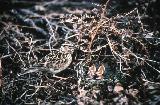|
 
- This is another of the region's special birds. Woodlarks were never common in the UK, but their numbers decreased during the 20th century to as few as 100 pairs in the early 1960s. In the 1970s, birdwatchers used to come to Thetford Forest area specifically to see this diminutive, brown bird, where it was fairly easily found.
Even before spring is in the air, Woodlarks begin their display, rising high in the air above clearings, issuing a beautiful series of fluty descending phrases, seemingly going on for ever as they drift higher and higher. The rest of their life is spent without drawing attention to themselves, moving around a lot on the ground, where they also build their nests.
Like the Nightjar, Woodlarks have taken to the habitat produced by tree felling in the forest. They quickly colonise newly cleared areas and are soon present at densities greater than that of Nightjars. Ron Hoblyn, who used to work for the Forestry Commission, now Forest Enterprise, has studied Woodlarks for many years and continues to do so. He has seen the rise in population of Woodlarks, as well as having been instrumental in some on the conservation practices that have helped this special bird. In 2000, there were over 50 pairs in and around Santon Downham alone.
|
|
|
|
|
|
|
|
|
|
|
|
|
|
|
|
|
|
|
Copyright 2016 TJKSoftware,Icehouse Media, ~ designed & maintained by
TJKSoftware
